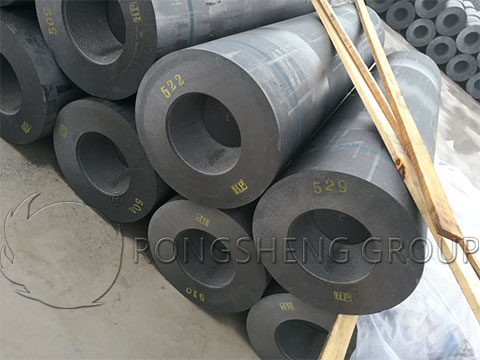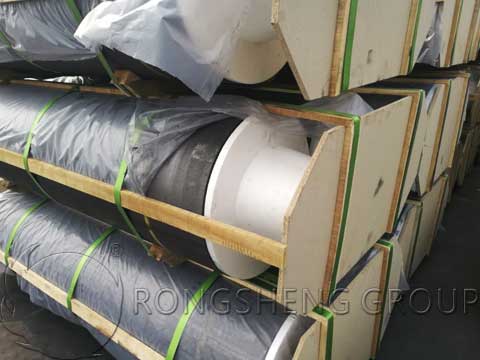The electrode is an important part of the electric furnace and a part of the secondary conductors and terminals. Relying on the electrodes to send the low voltage and large current from the furnace transformer to the furnace, the electric arc at the end of the electrode, the resistance of the charge, and the melt in the furnace, convert the electrical energy into heat for high-temperature smelting. Therefore, keeping the electrodes in a good and normal state is of great significance to reducing electrode accidents. What are the classifications of electrodes? What kind of electrodes are graphite electrodes? Graphite electrode manufacturers will answer your questions.

Classification of Electrodes
Carbon electrodes can be divided into three types according to their manufacturing processes. Carbon electrodes, graphite electrodes, and self-baking electrodes.
The carbon electrode is made of low-ash anthracite, metallurgical coke, pitch coke, and petroleum coke. Add binder pitch and tar after mixing in a certain proportion and particle size. Stir uniformly at an appropriate temperature, then press to shape, and finally slowly roast in a roasting furnace.
Graphite electrodes are mainly made of petroleum coke and pitch coke as raw materials. After the carbon electrode is made, it is obtained by graphitization by putting it in a graphitization resistance furnace with a temperature of 2000 to 2500 ℃ and isolating air. It is widely used in the production of industrial silicon products with low iron content and refined products with low carbon content.
The self-baking electrode is made of anthracite, coke, pitch, and tar as raw materials, and made electrode paste at a certain temperature. Then the electrode paste is put into the electrode shell made of steel plate that has been installed on the electric furnace, and it is made by sintering and coking. Widely used in submerged arc furnaces, self-baking electrodes are used in the production of ferrosilicon, high-carbon ferromanganese, high-carbon ferrochrome, silicon-manganese alloy, silicon-calcium alloy, etc.

Electrode Materials Need to Meet the Following Requirements
- It has good conductivity and the resistivity is small. In order to reduce the power loss when the current passes through the electrode, and reduce the voltage drop of the short network. Increase the effective voltage and increase the power of the molten pool.
- The coefficient of linear expansion should be small. When the temperature changes drastically, it is not easy to deform. The internal stress does not cause small cracks to increase electrical resistance due to temperature changes, and it has good thermal conductivity.
- It must have sufficient mechanical strength. The electrodes of submerged arc furnaces are subject to tension, compression, bending, and stress during use.
- The impurity content should be low. The electrode material contains as little as possible harmful impurities that contaminate the alloy.
- It is cheap and easy to manufacture. Carbonaceous materials have a wide range of sources, low prices, and meet the above requirements. Therefore, the electrodes of ferroalloy electric furnaces are currently made of carbon materials.
Comparison of the Main Performance of Electrodes
During the use of the electrode, users all hope that the specific resistance and linear expansion coefficient of the electrode should be smaller, and the thermal conductivity, electrical conductivity, compressive strength, bending strength, and tensile strength should be larger. Among them, the properties of graphite electrodes are relatively good. Resistivity is the most important performance of the electrode. According to the change of resistivity of graphite electrode and carbon electrode with temperature, it can be known that the resistivity of graphite electrode is smaller than that of carbon electrode. The resistivity of the carbon electrode gradually decreases with increasing temperature. The fired self-baking electrode is a very uniform amorphous carbon electrode, so its performance is similar to that of the carbon electrode. According to the graph of the thermal conductivity of graphite electrodes and carbon electrodes versus temperature, it can be seen that the thermal conductivity of graphite electrodes is larger than that of carbon electrodes, but it decreases with increasing temperature. On the contrary, the thermal conductivity of carbon electrodes increases as the temperature increases.
Electrode Consumption
In the smelting process, electrode consumption is inevitable. Different types of smelted alloys have different electrode consumption. In the ferroalloy production process, there are many factors that affect electrode consumption, such as the type, nature, and smelting operation of the electrode that can affect electrode consumption. As the unit power consumption of the product increases and the current density increases, the electrode consumption also increases accordingly.
To purchase high-quality graphite electrodes, in order to better reduce the consumption of graphite electrodes in use and save production costs, please contact us. We will provide you with the most suitable products for your production needs according to your needs.

